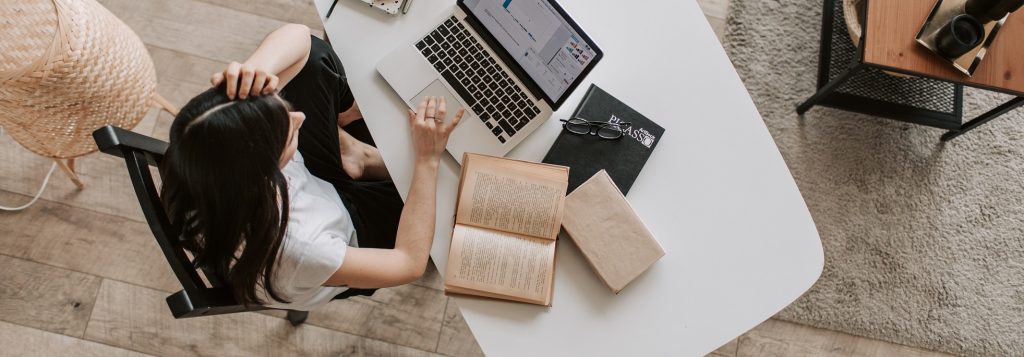
We called it in 2020. Three years have passed, and now we know. The work-from-home and hybrid office trends that followed the 2020 office shutdowns have settled down into a comfortable norm.
In 2021, Upwork predicted that a fifth of U.S. jobs would be remote by 2025. If so, that would be 87% higher than the norm before Covid.
To meet continued demand, architects now design homes to appeal to the remote-work lifestyle. In new construction, dedicated workspaces have become essential floorplan elements.
Essential: Dedicated Workspaces at Home
In early 2023, Zillow told Business Insider that “home office” turned up in more than 10% of residential real estate listings. That reflects a major rise! The number of “home office” (or “Zoom room”) mentions was less than 5% last year.
A dedicated work space (or two) in the home tends to draw buyers. When an agent lists a home for sale with dedicated space for remote work or video conferencing, that home can be expected to sell faster than comparable homes without those features, according to Zillow’s research. By 2022, buyers were willing to pay a 1.6% premium for a home with integrated office space, the company reports. No wonder construction firms have noticed a market for converting attics and basements into office spaces, or creating new offices as home additions.
In today’s home design, classic styles mesh with modern working spaces. Larger homes now often come with two offices, equipped for online meetings. Up-to-date wi-fi systems are as important today as landlines were in the 20th century.
Making great spaces for videoconferencing is all part of the design. Whether you’d like to broadcast in front of city skylines, or prefer to host meetings with an elegant mural behind you, there are wallpapers for creating the perfect Zoom backdrop, too.
Will the value last until the homeowner decides to sell? Likely so. The remote work lifestyle is much more than a passing trend. Companies like Wayfair, Ikea, and Amazon are breaking records in the home office furniture market.
“While many employers are working hard to get their employees back into the office,” the U.S. News & World Report recently observed, “it appears to be a tough road given the pushback on commuting versus WFH [work from home].”
Super Popular: The Office Nook

Business Insider takes note of the Arkansas design firm Verdant Studio, which now plans homes with “office nooks” in kitchens.
Sometimes, these spaces can go back to culinary duties after performing their day jobs. A home might feature an island in the kitchen that can be raised or lowered, to work as a desk in the daytime and a counter in the evening.
And homeowners are turning previously unused space, wherever it might be, into work rooms. Guest rooms, pantries, walk-in closets — all are potential office nook makeover projects.
Plus, plenty of companies are talking up a DIY form of the office nook trend. An online search for “modular desk” will show you a multitude of ways to install modular bookshelves and desks to create tiny home offices. The Vitsoe company is just one firm that’s turning this lifestyle project into an art.
Home Life, Now in a New Light
Homes that bring light in from the outside — through windows, glass door accents, skylights — are naturals. But ring lights and light-toned walls do a lot for a home office, too. Some homes now come with ceiling lighting designed to brighten up video conferences. The lights can be set to warm or cool, bright or normal, to compensate for time zone differences and make nighttime calls look like perfect daylight.
Sound matters too.
Better Homes & Gardens notes that households are noisier during the day now, and quiet workarounds are important. Home architecture and design now integrates double walls and window panes, and better insulation — now for low sound as well as high energy efficiency. There’s special insulation geared for buffering noises. Floors can be layered with sound-buffering material. Laminated glass, and even regular weatherstripping, also keep the noise down.
To augment the functionality of a new workspace, the home-based worker might add a small meeting space furnished for clients; elegant art; a very good office chair or adjustable standing desk; and a whiteboard.
Another vital way to support good concentration at home? Set up separate office spaces for each person, if two or more people are working out of the home. Bedrooms and playrooms should be separate from home offices.
A House Divided? Sure — Wherever It Needs to Be
Some homeowners bring their remote or hybrid lives subtly into their homes. Others are pleased and proud to have created bold and beautiful work-from-home niches.
French doors can separate an office nook off from the main floorplan. There are also Dutch doors, whose top sections open and close. These can allow everyone in the home to stay connected. Yet they can keep the work area separate when necessary.
Working areas can also be set off from connected rooms by being a step higher or lower. Even the use of wall paints can be effective to show where the general living space ends, and a work-from-home area begins.
Boundaries are important for a working mindset, and, of course, for income taxes. A well-defined, separate space in a home that’s used regularly and exclusively for business can qualify for tax deductions. In contrast, flexibly used spaces don’t get that tax break.
☛ Tax issues get complicated at the intersection of home life and business. Tax laws at local, state, and federal levels occasionally change, too. Consult with a tax professional for situation-specific advice.
Post-2020, Our Homes Work With Us
What a transformation we have witnessed in just three years. Remote or hybrid work used to be a sort of nonstandard life choice.
But then we experienced a pandemic. Businesses, to adapt, shifted to cloud-based data systems. Even the people who used to shun technology were jumping into Microsoft Teams like old pros within weeks. For those who made a lasting shift to a remote work lifestyle, the office at home needs to be as complete and functional as an office at a business campus.
Now, the idea of bringing work home is a mainstream concept. For many people today, a home is not only a place to come back to after a day’s work. A home has become valuable business space, and a partner in our careers.
Supporting References
Stephanie Stacey for Business Insider (Insider Inc.): “Zoom Rooms” and Dutch Door Offices Show How Remote Work Is Changing the Way We Build new Homes (Mar. 11, 2023; also appearing under the title “Zoom Rooms” and Hideaway Offices Show How Remote Work Is Changing the Way We Design New Homes).
Cori Sears for Better Homes & Gardens (Dotdash Meredith publishing): Soundproofing Your Space May Be the Secret to a More Peaceful Home (Mar. 13, 2023).
Steven Gottlieb for the U.S. News & World Report: How to Set Up a Home Office (Aug. 24, 2022).
Hamish Murray Construction Inc.: Why Building a Home Office Is the Perfect Addition to Your Home (undated blog entry).
And as linked.
Photo credits: Vlada Karpovich and Antoni Shkraba, via Pexels.
